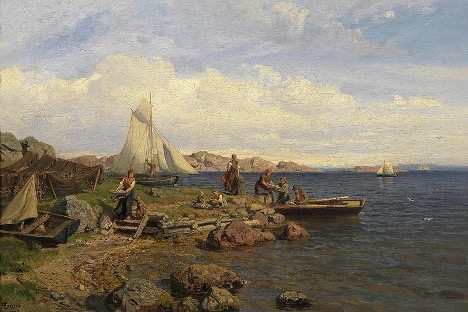Saved by the Sea? The Survival, Adaptation, and Development of Coastal Communities and the Fisheries During the 1740-1743 Famine Years in Norway

Wanda Marcussen
The early 1740s was a period of significant struggles in many parts of Europe, as especially cold weather and failed harvest caused famine and violent epidemics. Many studies have been done on the harsh experience in Ireland of the event known as “the Irish famine”. However, demographic records suggest that the 1740-1743 famine years in Norway were the most severely affected by the cold climate alongside conditions for growing crops that were already challenging so far north.
John Post has calculated that mortality in Norway in 1740-1742 increased 81% compared with 1735-1739, highlighting the magnitude of the crisis. While there were significant struggles on land during the early 1740s, there are also accounts of good fisheries from many parts of the coast. This coincides with a steady increase in the export of cod and herring. The period between 1740 and 1760 is considered a great period for the fishing industry in Norway, the country even with the largest export of herring in Europe.
Looking into The reports in response to 43 questions from the Danish Chancellery which was sent to the Danish Chancellery in Copenhagen by Norwegian priests and public officials in 1743, I explored how coastal communities in Norway fared during the crisis years of the early 1740s. The accounts give fruitful insights into the experience of the crisis years, as the men who provided answers for the report had recently seen the effects of the failing harvests on the local population and the coping mechanisms taken up by those who struggled.
Drawing on the sources, I found that there was a bountiful occurrence of fish along the Norwegian coast during the crisis years, which provided relief and much-needed sustenance and nutrition to the struggling people. The reason for the sound marine harvests is not clear, but the findings suggest that the climatic event might have had a positive effect on the bioproductivity of the ocean while a negative one on the productivity of the land. Statistics of deaths per birth in 1741 and 1742 do suggest that the death surplus was more severe in the inland and landlocked regions, the highest mortality peaks being in parishes located in the inland Akershus region. However, there are regional differences. The occurrence of diseases, many entering the country through the West Coast trading towns, makes the reality of the survival in coastal regions more wielded and unclear due to access to marine foodstuff. Still, with the accounts from around the country explaining how important the marine foodstuff and the especially good fisheries were for the poor and potentially starving people, the thesis concludes that fish did provide relief in these communities during the failed harvest years. This relief provided by the ocean affected migration patterns, as the sources suggest that many migrants sought refuge by the coast when the harvest failed. In other words, the accounts of good fisheries and the death records confirm that marine resources provided relief during the failed harvest years of the 1740s, and that the coastal communities responded to the crises better than most inland regions.
The Growth of Fisheries During the 1740-1743 Famine Years in Norway.
The abundant fisheries during the 1740s crisis years did not only provide relief for the coastal communities, but also had other economic and societal repercussions. The productive fisheries made investments in more advanced harvest and processing techniques more available. The sources explain that the existing harvest gear was sufficient to provide for the locals in most places, but the adaptation of nets and larger ships occurred along the West and North Coast as merchants sought to increase export to new markets. Previous to the 1740s, the Norwegian had relied on much simpler fishing methods than the Dutch and the British. For example, they did not engage in deep-sea fishing as much as their Dutch and British counterparts, but this situation started to change around 1740. The phenomenon that the advancement of fisheries along the coast was due to an abundance of resources is contrary to the common perception that technological progress is often caused by the need for adaptation due to challenging climate and/or general hardship providing food and livelihoods. The climate was challenging during the 1740s when adaptations in the fisheries took place, but in the research I found that the transformation was not due to the failed harvest on land but rather due to the riches of the sea.
Further, the research showed that new markets, better prices, abundant fish, and new processing methods on the West Coast fueled capitalist interest and incentives around 1740, increasing foreign export. In this way, the focus of fisheries shifted from individual demand to more processing and trade with an aim to generate income from fishing activities. However, this adaptation took time. Also, the accounts left from ca. 1743 suggest that the harvest of marine resources was primarily used to feed the local communities during the crisis years, where only the surplus was exported. This is a significant finding that for the most part the marine resources were available for those who needed them the most, as it brings new insights into the coping mechanisms and distribution patterns and policies during famine and crisis years in early modern Norwegian society. Compared to distribution of agricultural foodstuff, much less studies have been conducted on the distribution of marine resources and on the trajectories of its development during this period. . Hopefully, this finding will inspire future research on the topic.
1. Post, “Climate Variability and European Mortality Wave of the Early 1740s”, 13 2. Poulsen, Dutch herring An environmental history, c. 1600-1860, 49
Image Fiskerne kommer i land, Hans Gude (1878).

